Statistical Analysis of Polymer Nanocomposites for Mechanical Properties
Abstract
:1. Introduction
2. Materials and Methods
2.1. Preparation of Nanocomposites
2.2. Tensile Testing of Nanocomposites
3. Results and Discussions
3.1. Machine Learning Analysis on Tensile Test
3.2. Machine Learning Analysis on Stress vs. Strain Plots of Tensile Test
3.3. Flexural Testing of Nanocomposites
3.4. Flexural Tests
3.5. Morphological Characteristics
3.6. Scanning Electron Microscopy
3.7. Energy Dispersive X-ray Analysis
4. Conclusions
Author Contributions
Funding
Acknowledgments
Conflicts of Interest
Sample Availability
References
- Shokrieh, M.M.; Saeedi, A.; Chitsazzadeh, M. Mechanical properties of multi-walled carbon nanotube/polyester nanocomposites. J. Nanostructure Chem. 2013, 3, 20. [Google Scholar] [CrossRef] [Green Version]
- Haradanahalli, M.; Raghavan, B. Structured Lifing Approach to Fretting Fatigue of Ti-6Al-4V with Variable Initiation Length. In Proceedings of the 50th AIAA/ASME/ASCE/AHS/ASC Structures, Structural Dynamics, and Materials Conference 17th AIAA/ASME/AHS Adaptive Structures Conference 11th AIAA No 2009, Palm Springs, CA, USA, 4–7 May 2009; p. 2628. [Google Scholar]
- de Paiva, J.M.F.; De Nadai, A. Investigation of Carbon Composites Subjected to Different Environmental Conditions. Mater. Res. 2009, 12, 367–374. [Google Scholar]
- Paiva, J.M.; Santos, A.D.; Rezende, M.C. Mechanical and morphological characterizations of carbon fiber fabric reinforced epoxy composites used in the aeronautical field. Mater. Res. 2009, 12, 367–374. [Google Scholar] [CrossRef] [Green Version]
- Ogasawara, T.; Ishida, Y.; Kasai, T. Mechanical properties of carbon fiber/fullerene-dispersed epoxy composites. Compos. Sci. Technol. 2009, 69, 2002–2007. [Google Scholar] [CrossRef]
- Ma, P.C.; Siddiqui, N.A.; Marom, G.; Kim, J.K. Dispersion and functionalization of carbon nanotubes for polymer-based nanocomposites: A review. Compos. Part A Appl. Sci. Manuf. 2010, 41, 1345–1367. [Google Scholar] [CrossRef]
- Afzal, A.; Kausar, A.; Siddiq, M. Technical relevance of polymer/cement/carbon nanotube composite: Opportunities and challenges. Polym.-Plast. Technol. Eng. 2016, 55, 1743–1764. [Google Scholar] [CrossRef]
- Tekinalp, H.L.; Kunc, V.; Velez-Garcia, G.M.; Duty, C.E.; Love, L.J.; Naskar, A.K.; Blue, C.A.; Ozcan, S. Highly oriented carbon fiber–polymer composites via additive manufacturing. Compos. Sci. Technol. 2014, 105, 144–150. [Google Scholar] [CrossRef] [Green Version]
- Garg, P.; Singh, B.P.; Kumar, G.; Gupta, T.; Pandey, I.; Seth, R.K.; Tandon, R.P.; Mathur, R.B. Effect of dispersion conditions on the mechanical properties of multi-walled carbon nanotubes based epoxy resin composites. J. Polym. Res. 2011, 18, 1397–1407. [Google Scholar] [CrossRef]
- Demircan, Ö.; Çolak, P.; Kadıoğlu, K.; Günaydın, E.; Demircan, O.; Çolak, P.; Kadıoğlu, K.; Gunaydın, E. Flexural properties of glass fiber/epoxy/MWCNT composites. Res. Eng. Struct. Mater. 2019, 5, 91–98. [Google Scholar]
- Her, S.C.; Chien, P.C. Mode II Interfacial Fracture Toughness of Multi-Walled Carbon Nanotubes Reinforced Nanocomposite Film on Aluminum Substrate. Nanomaterials 2020, 10, 904. [Google Scholar] [CrossRef]
- Vahedi, F.; Shahverdi, H.R.; Shokrieh, M.M.; Esmkhani, M. Effects of carbon nanotube content on the mechanical and electrical properties of epoxy-based composites. New Carbon Mater. 2014, 29, 419–425. [Google Scholar] [CrossRef]
- Vahedi, F.; Shahverdi, H.R.; Shokrieh, M.M.; Esmkhani, M. Effects of carbon nanotube content on the mechanical and electrical properties of epoxy-based composites. Carbon 2015, 85, 455. [Google Scholar] [CrossRef]
- Mičušík, M.; Omastová, M.; Krupa, I.; Prokeš, J.; Pissis, P.; Logakis, E.; Pandis, C.; Pötschke, P.; Pionteck, J. A comparative study on the electrical and mechanical behaviour of multi-walled carbon nanotube composites prepared by diluting a masterbatch with various types of polypropylenes. J. Appl. Polym. Sci. 2009, 113, 2536–2551. [Google Scholar] [CrossRef]
- Dalina, W.W.; Tan, S.H.; Mariatti, M. Properties of fiberglass/MWCNT buckypaper/epoxy laminated composites. Procedia Chem. 2016, 19, 935–942. [Google Scholar] [CrossRef] [Green Version]
- Tariq, F.; Shifa, M.; Baloch, R.A. Mechanical and thermal properties of multi-scale carbon nanotubes–carbon fiber–epoxy composite. Arab. J. Sci. Eng. 2018, 43, 5937–5948. [Google Scholar] [CrossRef]
- Gantayat, S.; Rout, D.; Swain, S.K. Mechanical properties of functionalized multiwalled carbon nanotube/epoxy nanocomposites. Mater. Today Proc. 2017, 4, 4061–4064. [Google Scholar] [CrossRef]
- Gantayat, S.; Rout, D.; Swain, S.K. Structural and electrical properties of functionalized multiwalled carbon nanotube/epoxy composite. In Proceedings of the AIP Conference Proceedings, Indianapolis, Indiana, 23–25 May 2016; Volume 1731, p. 050113. [Google Scholar]
- Zabihi, O.; Ahmadi, M.; Naebe, M. One-pot synthesis of aminated multi-walled carbon nanotube using thiol-ene click chemistry for improvement of epoxy nanocomposites properties. RSC Adv. 2015, 5, 98692–98699. [Google Scholar] [CrossRef]
- Jin, Y.; Zhang, Y.; Zhang, Q.; Zhang, R.; Li, P.; Qian, W.; Wei, F. Multi-walled carbon nanotube-based carbon/carbon composites with three-dimensional network structures. Nanoscale 2013, 5, 6181–6186. [Google Scholar] [CrossRef] [PubMed]
- Tsai, S.J.; Hofmann, M.; Hallock, M.; Ada, E.; Kong, J.; Ellenbecker, M. Characterization and evaluation of nanoparticle release during the synthesis of single-walled and multiwalled carbon nanotubes by chemical vapor deposition. Environ. Sci. Technol. 2009, 43, 6017–6023. [Google Scholar] [CrossRef]
- Loos, M.R.; Coelho, L.A.; Pezzin, S.H.; Amico, S.C. Effect of carbon nanotubes addition on the mechanical and thermal properties of epoxy matrices. Mater. Res. 2008, 11, 347–352. [Google Scholar] [CrossRef]
- Michelis, P.; John, V. Complete CNT disentanglement–dispersion–functionalisation in a pulsating micro-structured reactor. Chem. Eng. Sci. 2013, 90, 10–16. [Google Scholar] [CrossRef]
- Li, W.; Anthony, D.; Zha, J.; Su, Z.; Bai, J. On improvement of mechanical and thermo-mechanical properties of glass fabric/epoxy composites by incorporating CNT–Al2O3 hybrids. Compos. Sci. Technol. 2014, 103, 36–43. [Google Scholar] [CrossRef]
- Zakaria, M.R.; Hazizan, M.A.; Muhammad, H.A.K.; Halim, K. Improving flexural and dielectric properties of MWCNT/epoxy nanocomposites by introducing advanced hybrid filler system. Compos. Struct. 2015, 132, 50–64. [Google Scholar] [CrossRef]
- Xia, Z.; Chen, Y.; Ellyin, F. A meso/micro-mechanical model for damage progression in glass-fiber/epoxy cross-ply laminates by finite-element analysis. Compos. Sci. Technol. 2000, 60, 1171–1179. [Google Scholar] [CrossRef]
- Mandal, B.M. Conducting polymer nanocomposites with extremely low percolation threshold. Bull. Mater. Sci. 1998, 21, 161–165. [Google Scholar] [CrossRef] [Green Version]
- Schadler, L.S.; Brinson, L.C.; Sawyer, W.G. Polymer nanocomposites: A small part of the story. JOM 2007, 59, 53–60. [Google Scholar] [CrossRef]
- Shahapurkar, K.; Darekar, V.; Banjan, R.; Nidasosi, N.; Soudagar, M.E.M. Factors affecting the solid particle erosion of environment pollutant and natural particulate filled polymer composites—A review. Polym. Polym. Compos. 2020, 0967391120971411. [Google Scholar] [CrossRef]
- Kallannavar, V.; Kattimani, S.; Soudagar, M.E.M.; Mujtaba, M.A.; Alshahrani, S.; Imran, M. Neural Network-Based Prediction Model to Investigate the Influence of Temperature and Moisture on Vibration Characteristics of Skew Laminated Composite Sandwich Plates. Materials 2021, 14, 3170. [Google Scholar] [CrossRef] [PubMed]
- Jeevan, T.P.; Jayaram, S.R.; Afzal, A.; Ashrith, H.S.; Soudagar, M.E.M.; Mujtaba, M.A. Machinability of AA6061 aluminum alloy and AISI 304L stainless steel using nonedible vegetable oils applied as minimum quantity lubrication. J. Braz. Soc. Mech. Sci. 2021, 43, 1–18. [Google Scholar]
- Zhang, J.; Jiang, D. Interconnected multi-walled carbon nanotubes reinforced polymer-matrix composites. Compos. Sci. Technol. 2011, 71, 466–470. [Google Scholar] [CrossRef]
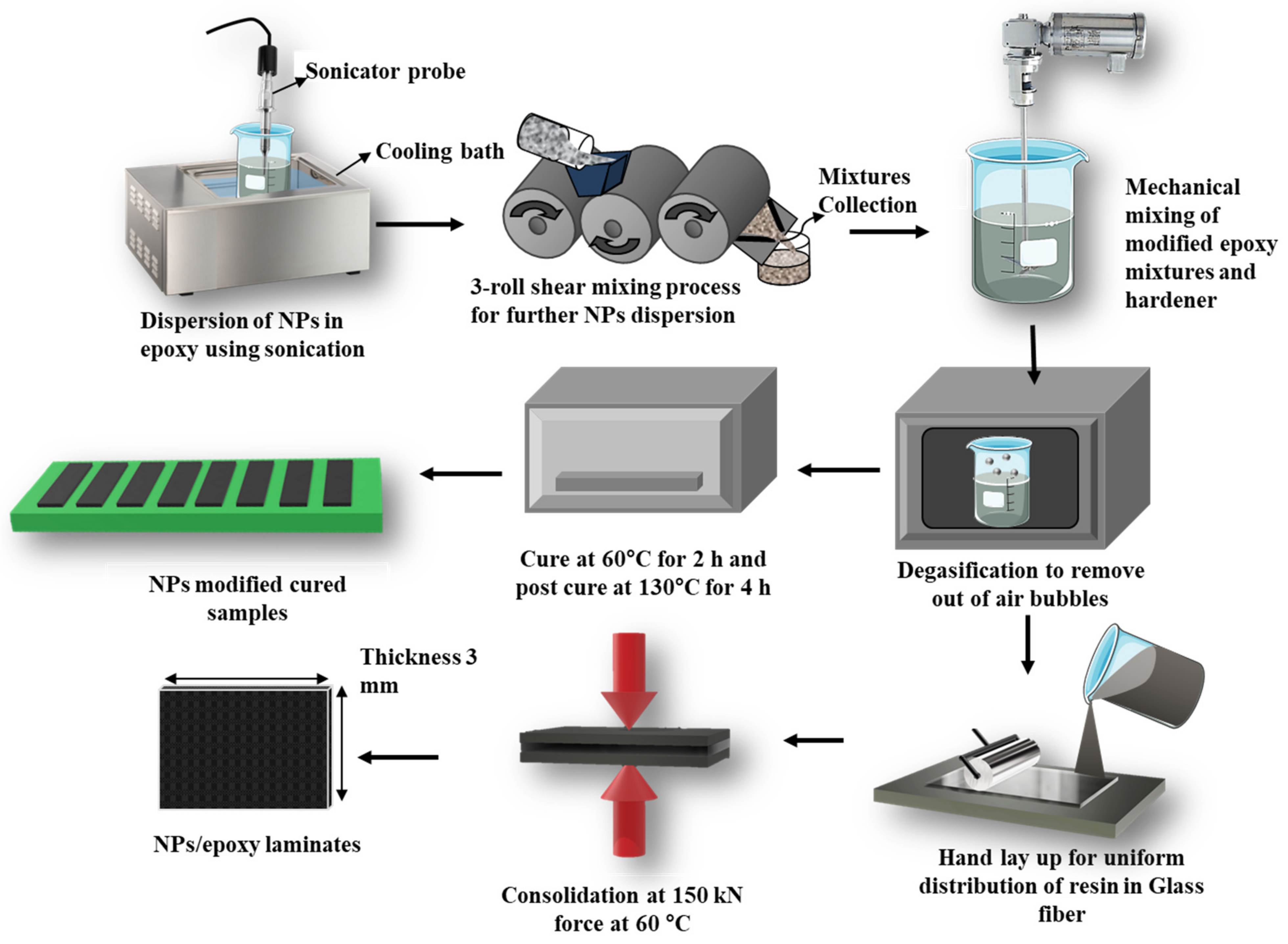
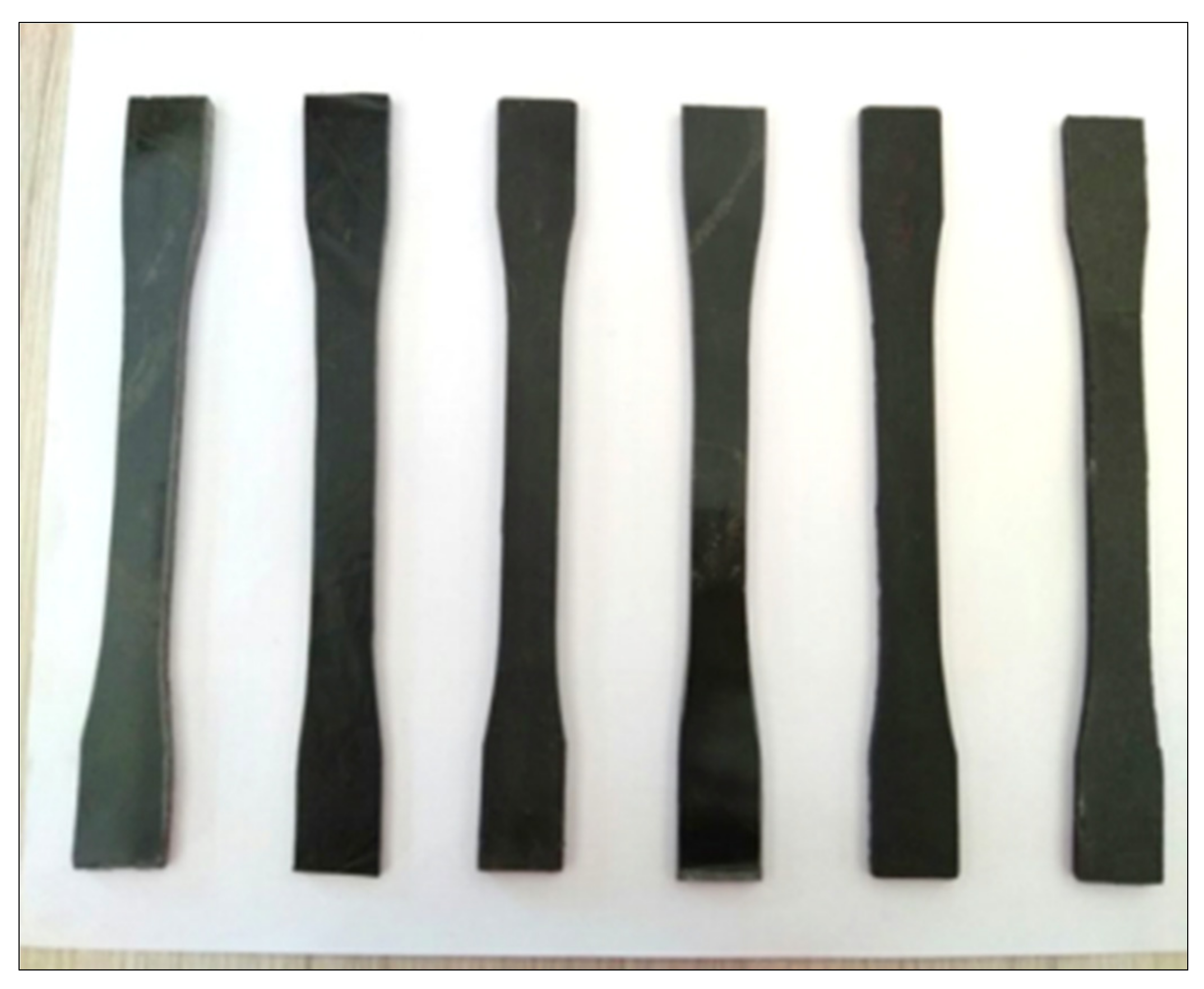


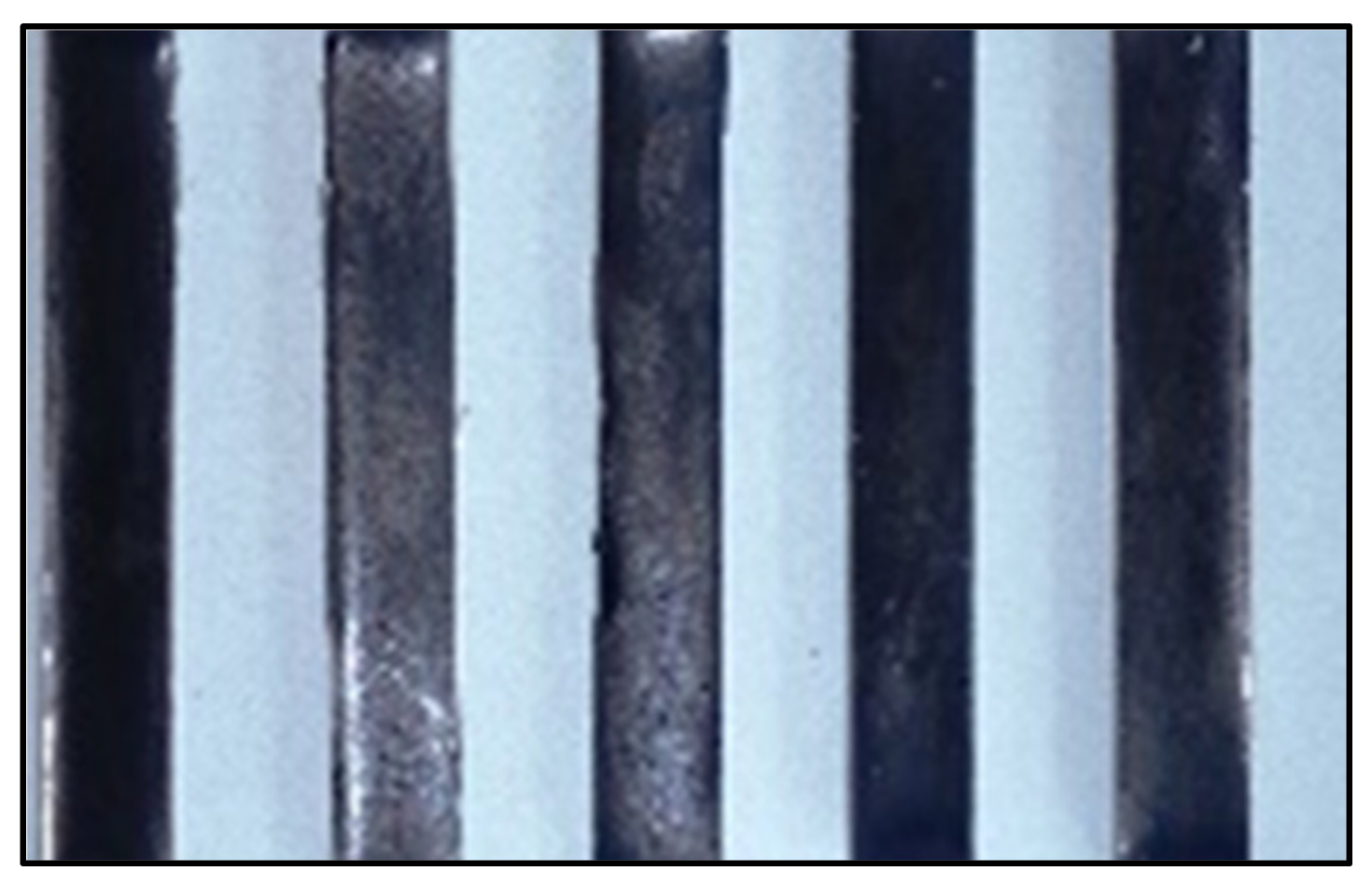
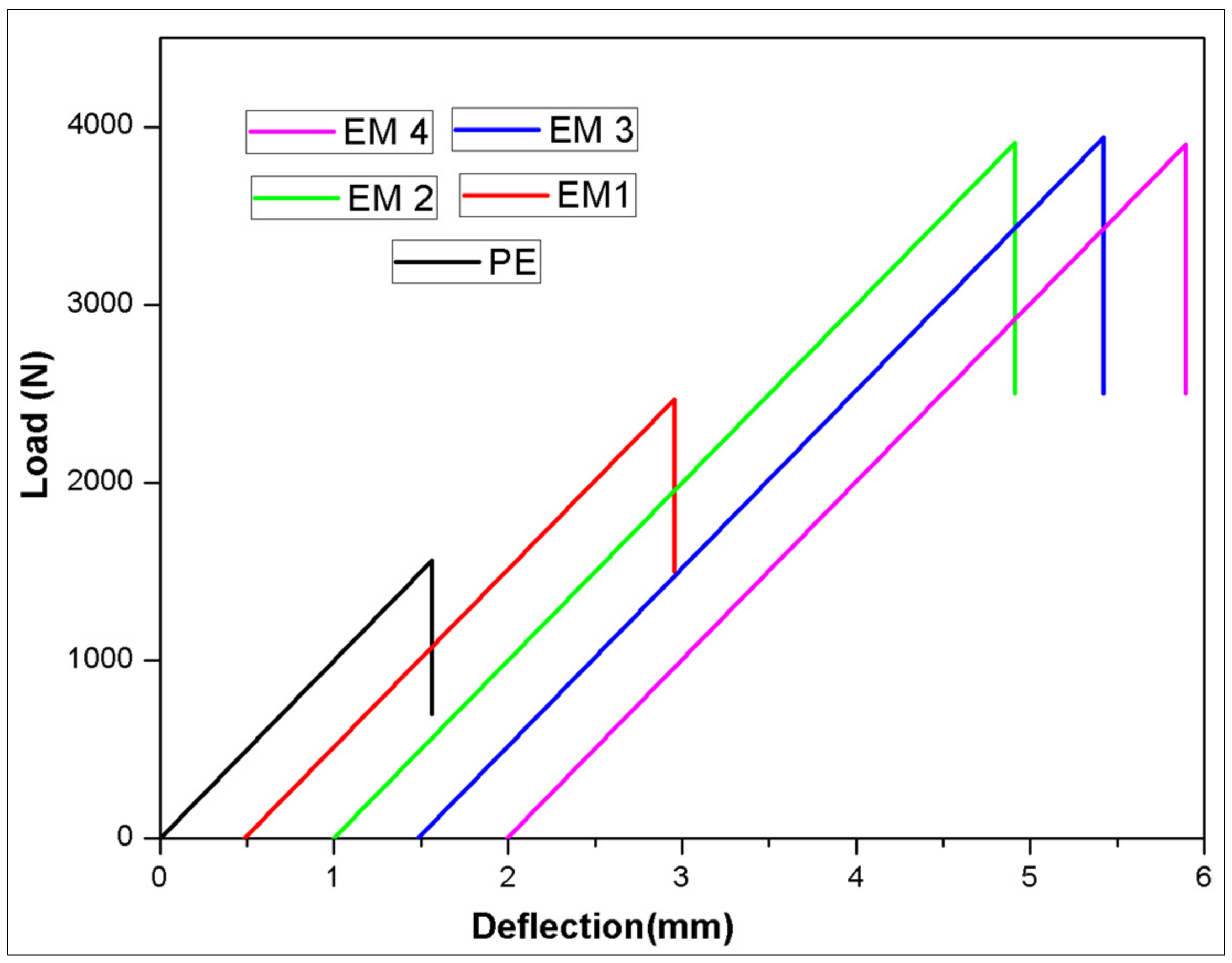

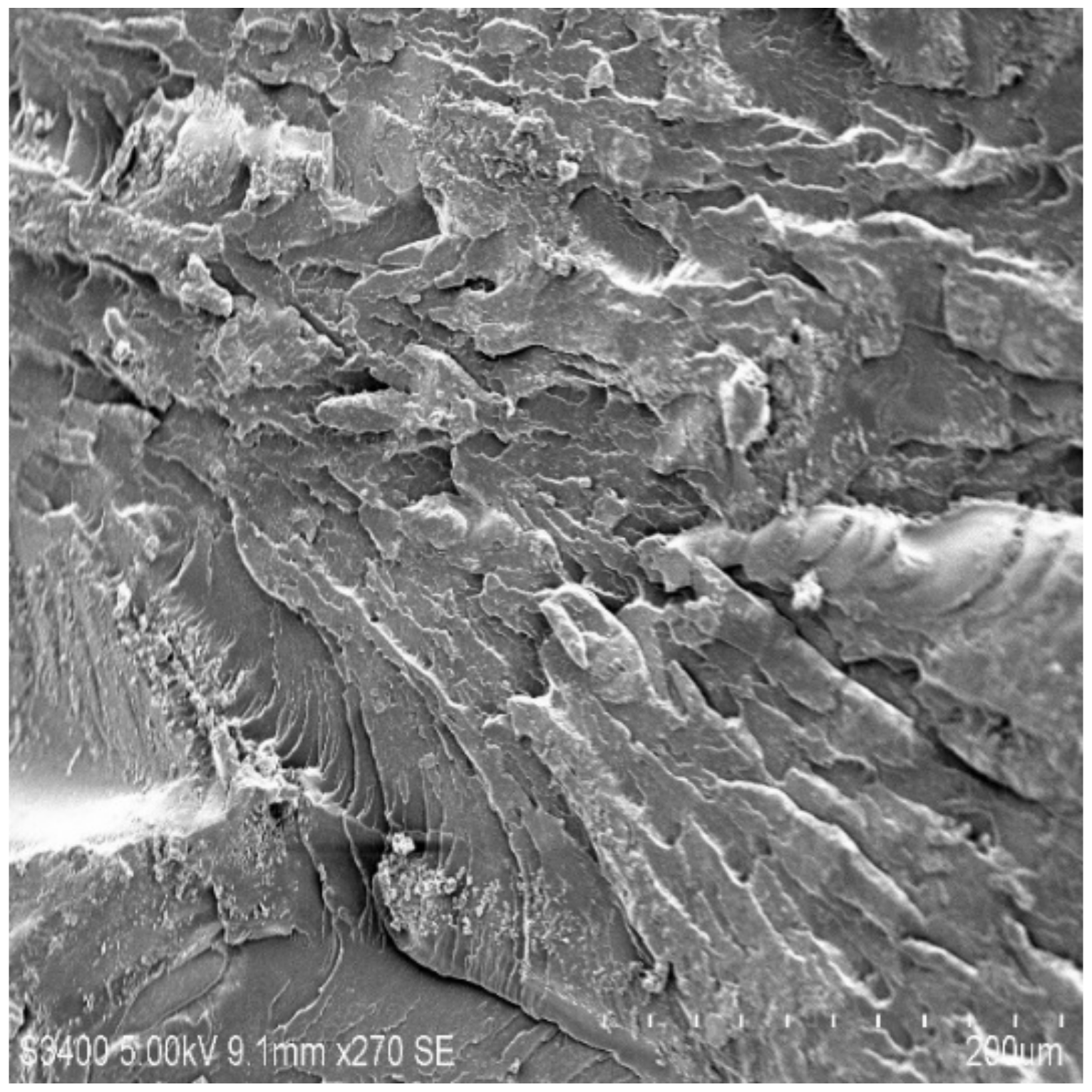
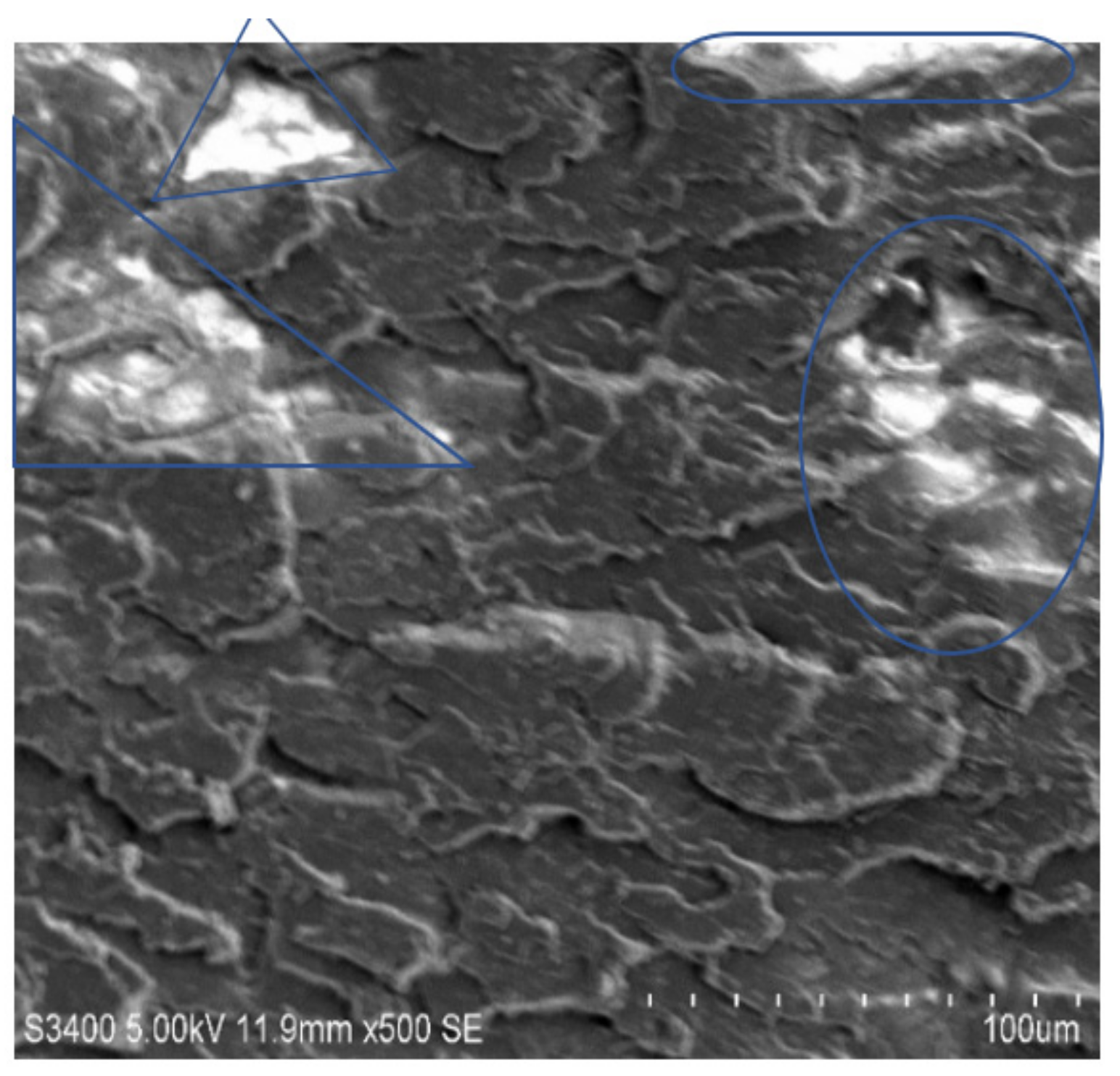

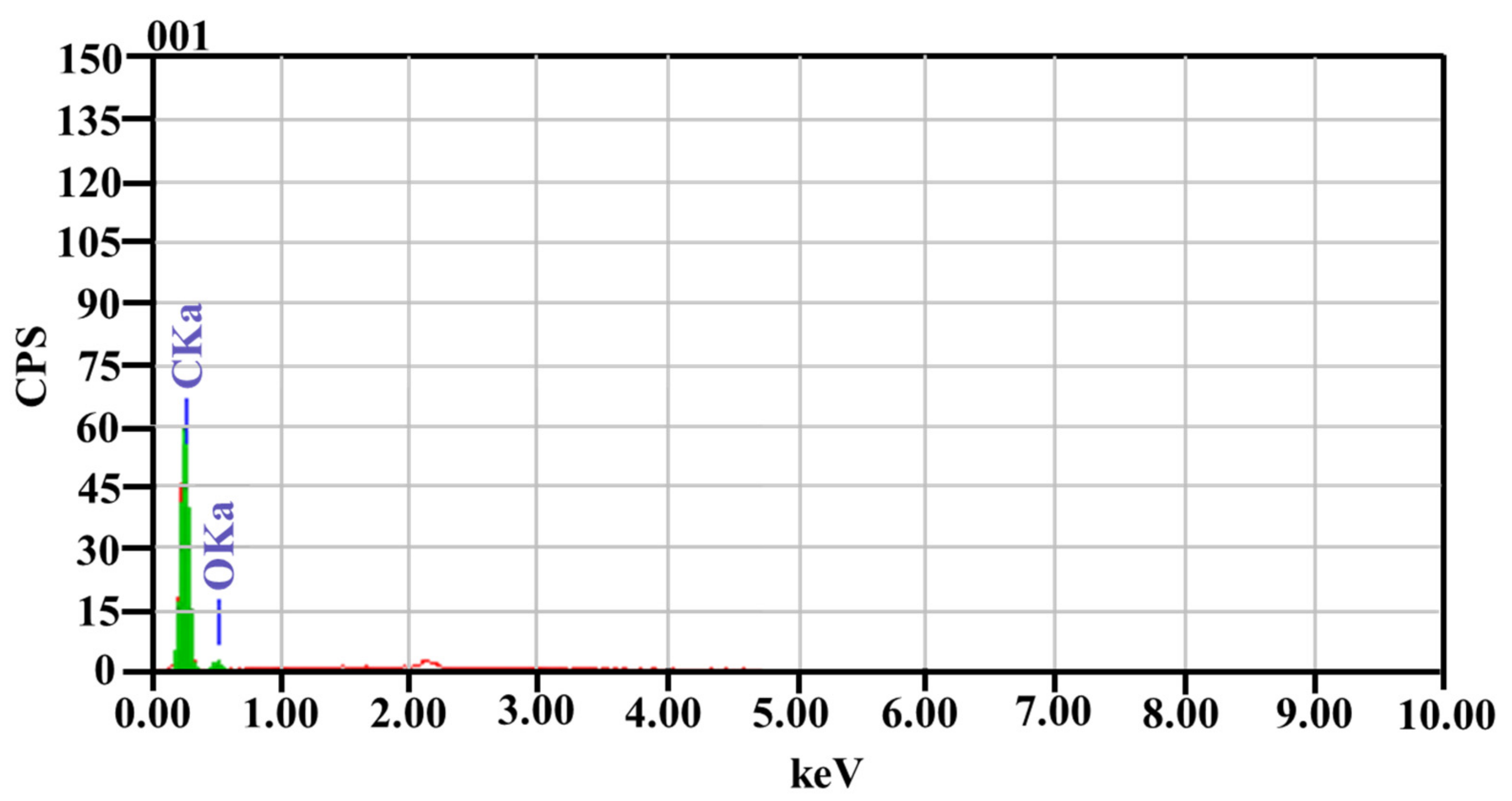
| Sl. No. | Specimen Composition | Specimen Coded |
|---|---|---|
| 1 | Plain Epoxy | PE |
| 2 | Epoxy + 0.1 wt.% (* w.r.t. Epoxy) of MWCNTs | EM1 |
| 3 | Epoxy + 0.2 wt.% (w.r.t. Epoxy) of MWCNTs | EM2 |
| 4 | Epoxy + 0.3 wt.% (w.r.t. Epoxy) of MWCNTs | EM3 |
| 5 | Epoxy + 0.4 wt.% (w.r.t. Epoxy) of MWCNTs | EM4 |
| Sl. No. | Composition | Ultimate Load (kN) | Ultimate Strength (N/mm2) | Deflection (mm) | Stress (N/mm2) | Strain | Young’s Modulus (N/mm2) |
|---|---|---|---|---|---|---|---|
| 1 | PE | 1.56 | 24.81 | 1.6 | 24.96 | 0.0066 | 3782 |
| 2 | EM1 | 2.47 | 42.24 | 3.5 | 39.52 | 0.0140 | 2823 |
| 3 | EM2 | 3.91 | 62.56 | 4.9 | 62.56 | 0.0196 | 3345 |
| 4 | EM3 | 3.94 | 63.04 | 6.3 | 63.04 | 0.0252 | 3680 |
| 5 | EM4 | 1.75 | 28.00 | 1.9 | 28.00 | 0.0076 | 3684 |
| R-Square (COD) | SD | N | p |
|---|---|---|---|
| 1 | 0 | 5 | <0.0001 |
| R | SD | N | p |
|---|---|---|---|
| 0.96721 | 0.00232 | 5 | 0.00709 |
| Sl. No | Specimen | Ultimate Load, N | Maximum Deflection in mm | Flexural Strength, MPa |
|---|---|---|---|---|
| 1 | PE | 1560 | 1.56 | 433 |
| 2 | EM1 | 2470 | 2.47 | 686 |
| 3 | EM2 | 3910 | 3.91 | 1086 |
| 4 | EM3 | 3940 | 3.94 | 1094 |
| 5 | EM4 | 3900 | 3.90 | 1083 |
| Element | (keV) | Mass% | Error% | At% | % Composition |
|---|---|---|---|---|---|
| C | 0.277 | 87.01 | 0.19 | 89.92 | 95.4910 |
| O | 0.525 | 12.99 | 2.60 | 10.08 | 4.5091 |
| Total | 100 | 100 |
Publisher’s Note: MDPI stays neutral with regard to jurisdictional claims in published maps and institutional affiliations. |
© 2021 by the authors. Licensee MDPI, Basel, Switzerland. This article is an open access article distributed under the terms and conditions of the Creative Commons Attribution (CC BY) license (https://creativecommons.org/licenses/by/4.0/).
Share and Cite
Hallad, S.A.; Banapurmath, N.R.; Khan, T.M.Y.; Umarfarooq, M.A.; Soudagar, M.E.M.; Hunashyal, A.M.; Gujjar, S.V.; Yaradoddi, J.S.; Ganachari, S.V.; Elfasakhany, A.; et al. Statistical Analysis of Polymer Nanocomposites for Mechanical Properties. Molecules 2021, 26, 4135. https://doi.org/10.3390/molecules26144135
Hallad SA, Banapurmath NR, Khan TMY, Umarfarooq MA, Soudagar MEM, Hunashyal AM, Gujjar SV, Yaradoddi JS, Ganachari SV, Elfasakhany A, et al. Statistical Analysis of Polymer Nanocomposites for Mechanical Properties. Molecules. 2021; 26(14):4135. https://doi.org/10.3390/molecules26144135
Chicago/Turabian StyleHallad, Shankar A., N. R. Banapurmath, T. M. Yunus Khan, M. A. Umarfarooq, Manzoore Elahi M. Soudagar, Anand M. Hunashyal, Sandeep V. Gujjar, Jayachandra S. Yaradoddi, Sharanabasava V. Ganachari, Ashraf Elfasakhany, and et al. 2021. "Statistical Analysis of Polymer Nanocomposites for Mechanical Properties" Molecules 26, no. 14: 4135. https://doi.org/10.3390/molecules26144135












